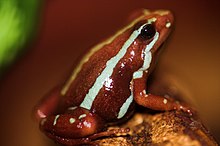Study more about Dart Frog:
Toxicity and medicine
See also: Allopumiliotoxin 267A, Batrachotoxin, Epibatidine, Histrionicotoxin, and Pumiliotoxin 251D
Many poison dart frogs secrete lipophilic alkaloid toxins through their skin. Alkaloids in the skin glands of poison frogs serve as a chemical defense against predation, and they are therefore able to be active alongside potential predators during the day. About 28 structural classes of alkaloids are known in poison frogs The most toxic of poison dart frog species is Phyllobates terribilis. It is argued that dart frogs do not synthesize their poisons, but sequester the chemicals from arthropod prey items, such as ants, centipedes and mites – the diet-toxicity hypothesis. Because of this, captive-bred animals do not possess significant levels of toxins as they are reared on diets that do not contain the alkaloids sequestered by wild populations. Nonetheless, the captive-bred frogs retain the ability to accumulate alkaloids when they are once again provided an alkaloid-containing diet. Despite the toxins used by some poison dart frogs, some predators have developed the ability to withstand them. One is the snakeLeimadophis epinephelus, which has developed immunity to the poison.
Chemicals extracted from the skin of Epipedobates tricolor may be shown to have medicinal value. Scientists use this poison to make a pain killer. One such chemical is a painkiller 200 times as potent as morphine, called epibatidine, that has unfortunately demonstrated unacceptable gastrointestinal side effects in humans Secretions from dendrobatids are also showing promise asmuscle relaxants, heart stimulants and appetite suppressants.The most poisonous of these frogs, the golden poison frog (Phyllobates terribilis), has enough toxin on average to kill ten to twenty men or about ten thousand mice. Most other dendrobatids, while colorful and toxic enough to discourage predation, pose far less risk to humans or other large animals.

Poison dart frogs, like this sapphire-blue species, are highly toxic. Their brilliant colors serve as warnings to potential predators to keep away.


沒有留言:
張貼留言